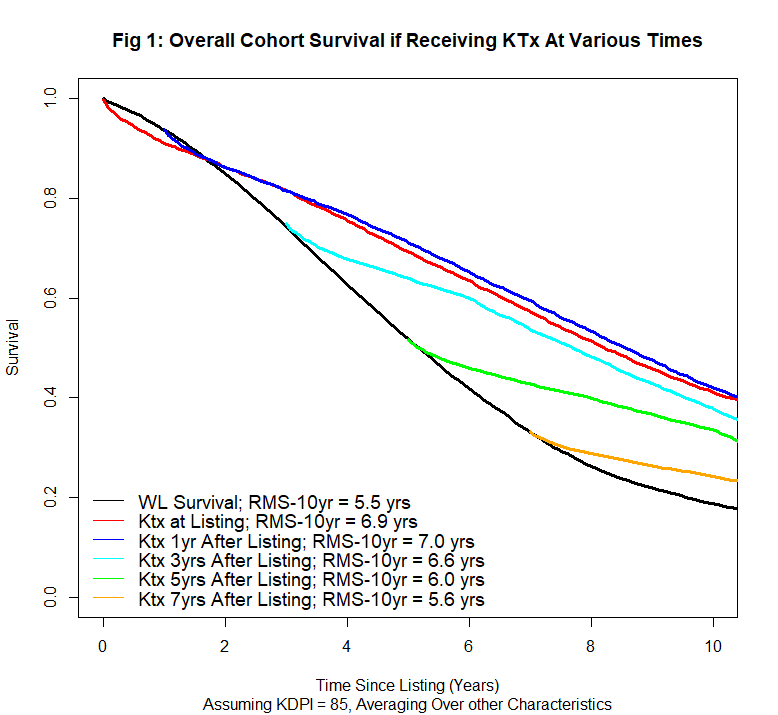A Machine Learning Approach to Estimating Anticipated Waiting Time and Survival Benefit in Older Kidney Transplant Candidates
D. M. Vock1, E. S. Helgeson2, A. J. Matas2
1University of Minnesota, Minneapolis, MN, 2U MN, Mpls, MN
Meeting: 2022 American Transplant Congress
Abstract number: 539
Keywords: Allocation, Elderly patients, Kidney transplantation, Waiting lists
Topic: Clinical Science » Organ Inclusive » 72 - Machine Learning, Artificial Intelligence and Social Media in Transplantation
Session Information
Session Name: Machine Learning, Artificial Intelligence and Social Media in Transplantation
Session Type: Rapid Fire Oral Abstract
Date: Tuesday, June 7, 2022
Session Time: 5:30pm-7:00pm
 Presentation Time: 6:10pm-6:20pm
Presentation Time: 6:10pm-6:20pm
Location: Hynes Room 210
*Purpose: Older kidney transplant (ktx) recipients face worse post-transplant survival due to increasing age and more comorbidities. Simultaneously, older ktx candidates are more likely to wait longer (increasing time on dialysis) or receive a higher KDPI kidney which further erodes post-transplant survival. There may be certain older recipients who based on their predicted wait times cannot expect a substantial benefit from a deceased donor (DD) transplant. We sought to estimate how long an older candidate can wait for a DD ktx and still expect a survival benefit given their characteristics.
*Methods: Using SRTR data, we identified candidates listed for first ktx alone after 2000 who were 60 years of age or older (n = 87,416 candidates, n = 27,594 DD recipients). We fit random survival forest models to estimate waitlist and post-DD ktx survival adjusting for candidate/recipient characteristics (e.g., demographics, comorbidities, functional status, time on dialysis) and donor/surgical characteristics (KDPI, ischemia time). Using these machine learning models, we estimated the expected survival under different waiting times for different quality of DD organs. We defined DD ktx as beneficial if the restricted mean 10-year survival (RMS-10yr) was increased by 0.5 yrs compared to remaining on the waiting list and calculated the maximum waiting time for a candidate to expect a benefit (referred as TIPPING POINT).
*Results: Among this cohort (median age 65.3 yrs, 63% male), candidates had significant comorbidities including 58% DM, 77% HTN, 12% angina, 5% CeVD, 9% PVD, and 10% prior malignancy. Overall, the benefit of DD ktx declined as waiting time increased (Fig 1). Averaging over other characteristics, the tipping point was approximately 5.4 years if the candidate received a higher-quality kidney (KDPI = 35) and just under 5 years for a lower-quality kidney (KDPI = 85, Fig 2). In general the tipping point was lower for candidates with comorbidities but did not very substantially by age at listing overall or within comorbid conditions (Fig 2).
*Conclusions: Potential ktx recipients who based on the organ availability in their region cannot expect to receive a DD transplant before the tipping point should be counseled to pursue living donor transplant.
To cite this abstract in AMA style:
Vock DM, Helgeson ES, Matas AJ. A Machine Learning Approach to Estimating Anticipated Waiting Time and Survival Benefit in Older Kidney Transplant Candidates [abstract]. Am J Transplant. 2022; 22 (suppl 3). https://atcmeetingabstracts.com/abstract/a-machine-learning-approach-to-estimating-anticipated-waiting-time-and-survival-benefit-in-older-kidney-transplant-candidates/. Accessed December 23, 2025.« Back to 2022 American Transplant Congress


